Torrieri D. Principles of Spread-Spectrum Communication Systems
Подождите немного. Документ загружается.

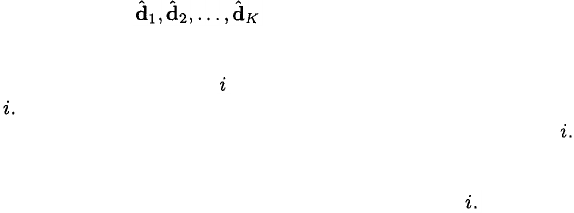
of the symbol streams transmitted by the K users. The input
may be the sampled outputs of a chip-matched filter for PSK modulation or the
complex-valued samples derived from a quadrature demodulator for quaternary
modulation. Detector-generator produces a replica of the signal transmitted
by user Its basic structure is depicted in Figure 6.23. The correlator, which
comprises a multiplier and summer as in Figure 6.15, despreads signal The
channel estimate is a stream of complex numbers that are applied to the cor-
relator output to remove the effects of the propagation channel. The decision
device produces the estimated symbols transmitted by user These symbols
are remodulated and modified to account for the effects of the channel. After
358
CHAPTER 6. CODE-DIVISION MULTIPLE ACCESS
An adaptive multiuser detector [23] is one that does not require explicit
knowledge of either the spreading sequences or the timing of the multiple-access
interference signals. The receiver samples the output of a wideband filter at the
chip rate. The use of short spreading sequences affords the opportunity for
the adaptive detector to essentially learn the sequence cross-correlations and
thereby to suppress the interference. The learning is accomplished by process-
ing a known training sequence of symbols for the desired signal during a train-
ing phase. This operational phase is followed by a decision-directed phase that
continues the adaptation by feeding back symbol decisions. Adaptive detectors
potentially can achieve much better performance than conventional ones at least
if the transmission channel is time-invariant, but coping with fast fading and
interference changes requires elaborate modifications. A blind adaptive detector
[24] is one that does not require training sequences. These detectors are desir-
able for applications such as system recovery but entail some performance loss
and complexity increase relative to other adaptive detectors. Long sequences
do not possess the cyclostationarity that makes possible many of the advanced
signal processing techniques used for blind multiuser detection and adaptive
channel estimation.
Interference Cancellers
An interference canceller is a multiuser detector that explicitly estimates the
interference signals and then subtracts them from the received signal to pro-
duce the desired signal. Interference cancellers may be classified as successive
interference cancellers in which the subtractions are done sequentially, parallel
interference cancellers in which the subtractions are done simultaneously, or
hybrids of these types. Only the basic structures and features of the successive
and parallel cancellers are presented subsequently. A large number of alterna-
tive versions, some of them hybrids, adaptive, or blind, have been proposed in
the literature [23]. Some type of interference canceller is by far the most prac-
tical multiuser detector for an asynchronous DS/CDMA network, especially if
long spreading sequences are planned [25].
Successive Interference Canceller
Figure 6.22 is a functional block diagram of a successive interference canceller,
which uses nonlinear replica generations and subtractions to produce estimates
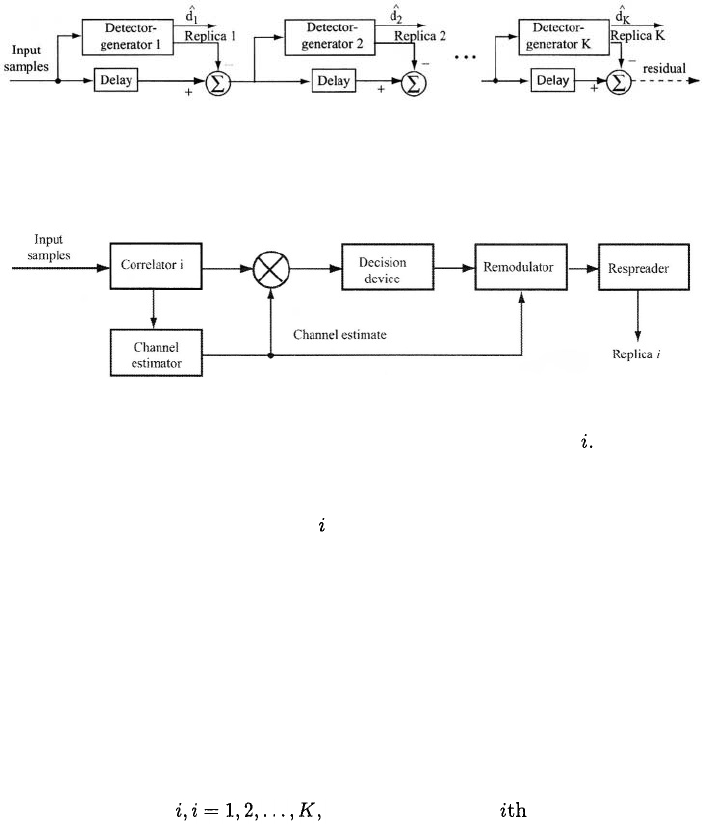
6.5.
MULTIUSER DETECTORS
359
Figure 6.22: Successive interference canceller with K detector-generators to
produce signal estimates for subtraction.
Figure 6.23: Structure of detector-generator for signal
a respreading, the replica of signal is generated and sent to the correspond-
ing subtracter. The input or output of the decision device may produce the
estimated symbol stream, depending on whether the decoder uses soft or hard
decisions. The channel estimator uses known pilot or training symbols to deter-
mine the effect of the channel. Hard decisions are used in the replica generation,
but may not be appropriate if the channel estimate is inaccurate because a sym-
bol error doubles the amplitude of the interference that enters the next stage
of the canceller of Figure 6.22. The enhanced interference adversely affects
subsequent symbol estimates and replicas.
The outputs of a set of K correlators and level detectors are applied to a
device that orders the K received signals according to their power levels. This
ordering determines the placement of the detector-generators in Figure 6.22.
Detector-generator corresponds to the strongest signal.
The first canceller stage eliminates the strongest signal, thereby immediately
alleviating the near-far problem while exploiting the superior detectability of the
strongest signal. The first difference signal is applied to the detector-generator
for the second strongest received signal, etc. The amount of interference re-
moval from a signal tends to increase from the strongest received signal to the
weakest one. The delay introduced, the impact of cancellation errors, and the
implementation complexity may limit the number of canceller stages to fewer
than K, and a set of conventional detectors may be needed to estimate some
of the symbol streams. At a low SNR, inaccurate cancellations may cause the
canceller to lose its advantage over the conventional detector. The successive
interference canceller of Figure 6.22 requires known spreading sequences and
timing of all signals.

360
CHAPTER 6. CODE-DIVISION MULTIPLE ACCESS
Figure 6.24: Second canceller of multistage canceller using successive interfer-
ence cancellers.
A multistage interference canceller comprising more than one successive in-
terference canceller potentially improves performance by repeated cancellations
if the delay and complexity can be accommodated. The second canceller or
stage of a multistage canceller is illustrated in Figure 6.24. The input is the
residual of canceller 1, which is shown in Figure 6.22. Replica 1 of canceller 1
is added to the input and then an improved replica of signal 1 is subtracted.
Subsequently, other replicas from canceller 1 are added and corresponding im-
proved replicas are subtracted. The symbol streams are produced by the final
canceller. Rake combining of multipath components may be incorporated into
a multistage or single-stage canceller to improve performance in a fading envi-
ronment [26].
Parallel Interference Canceller
A parallel interference canceller detects, generates, and then subtracts all multiple-
access interference signals simultaneously, thereby avoiding the delay inherent
in successive interference cancellers. A parallel interference canceller for two
signals is diagrammed in Figure 6.25. Each detector-generator pair may be
implemented as shown in Figure 6.23. Each of the final detectors includes a
digital matched filter and a decision device that produce soft or hard decisions,
which are applied to the decoder. Since all signals are processed in the same
manner and the initial detections influence the final ones, the parallel inter-
ference canceller is not as effective in suppressing the near-far problem as the
successive interference canceller unless the CDMA network uses power control.
Power control also relieves the timing synchronization requirements. A better
suppression of the near-far problem is provided by the multistage parallel inter-
ference canceller, in which each stage is similar but has an improved input that
results in an improved output. Figure 6.26 shows the multistage canceller for
two signals. Each stage has the form of Figure 6.25 without the final detectors.
Multiuser Detector for Frequency Hopping
Multiuser detection is more challenging for frequency-hopping systems than for
direct-sequence systems, but it is possible in principle. The hopping patterns

6.5.
MULTIUSER DETECTORS
361
Figure 6.25: Parallel interference canceller for two signals.
Figure 6.26: Multistage parallel interference canceller for two signals. D=delay.
of all users to be detected must be known. In an asynchronous frequency-
hopping network, the hop transition times serve as identifying parameters for
the network users and must be known by a receiver, which uses them to de-
termine when collisions will occur. The multiuser detector comprises a set of
single-user turbo decoders and an iterative decoding algorithm that exploits a
collaboration between the decoders and the demodulator [27]. If the number
of signals colliding during an interval is too large, then the symbols during that
interval are erased. The detector decodes the user’s signal with the smallest
number of erasures among the undecoded signals during a particular iteration.
Likelihood ratios associated with the symbols of a decoded codeword are fed
back to the demodulator to enable an improved demodulation of those unerased
symbols occurring during a collision with the decoded signal. Simulation results
indicate that an excellent performance may be possible, but the computational
complexity is high, and an implementation is impractical for most networks.
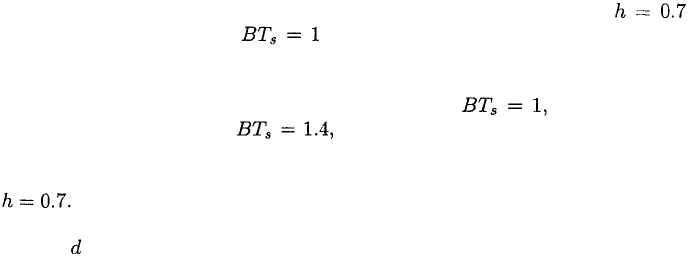
362
CHAPTER 6.
CODE-DIVISION MULTIPLE ACCESS
6.6
Frequency-Hopping Multiple Access
Two major advantages of frequency hopping are that it can be implemented
over a much larger frequency band than it is possible to implement direct-
sequence spreading, and that the band can be divided into noncontiguous seg-
ments. Another major advantage is that frequency hopping provides resistance
to multiple-access interference, while not requiring power control to prevent
the near-far problem. Since direct-sequence systems cannot escape the near-far
problem by hopping, accurate power control is crucial but becomes much less
effective as the fading rate increases. These advantages of frequency hopping
will be decisive in many applications. For example, the Bluetooth system and
combat net radios use frequency hopping to avoid the near-far problem.
Frequency-hopping systems are usually part of a frequency-hopping code-
division multiple-access (FH/CDMA) network in which all systems share the
same M frequency channels. In a synchronous FH/CDMA network, the systems
coordinate their frequency transitions and hopping patterns. Consequently, as
many as M frequency-hopping signals can be simultaneously accommodated
by the network with insignificant multiple-access interference at any of the
active receivers. Network coordination is much simpler to implement than for
a DS/CDMA network because the timing alignments must be within a small
fraction of a hop duration instead of a small fraction of a spreading-sequence
chip. Multipath signals and errors in range estimates can be accommodated
at some cost in the energy per information bit by increasing the switching
time between frequency-hopping pulses. However, some type of centralized or
cellular architecture is required, and such an architecture is often unavailable.
Asynchronous FH/CDMA Networks
An asynchronous FH/CDMA network has systems that transmit and receive
autonomously and asynchronously. When two or more frequency-hopping sig-
nals using the same frequency channel are received simultaneously, they are
said to collide. Since the probability of a collision in an asynchronous network
is decreased by increasing the number of frequency channels in the hopset, it
is highly desirable to choose a data modulation that has a compact spectrum.
Good candidates are FH/CPFSK systems that use a frequency discriminator
for demodulation. As explained in Chapter 3, binary CPFSK with
and bandwidth such that provides excellent potential performance
if the spectral splatter and intersymbol interference generated by this modu-
lation are negligible. However, for approximately the same degree of spectral
splatter and intersymbol interference as MSK with the bandwidth
must be increased so that which reduces the number of frequency
channels M in a fixed hopping band. This much reduction in M is enough to
completely offset the intrinsic performance advantage of binary CPFSK with
Thus, the choice between the latter and MSK or GMSK will depend on
the details of the impact of the spectral splatter and intersymbol interference.
Let represent the duty factor, which is defined as the probability that
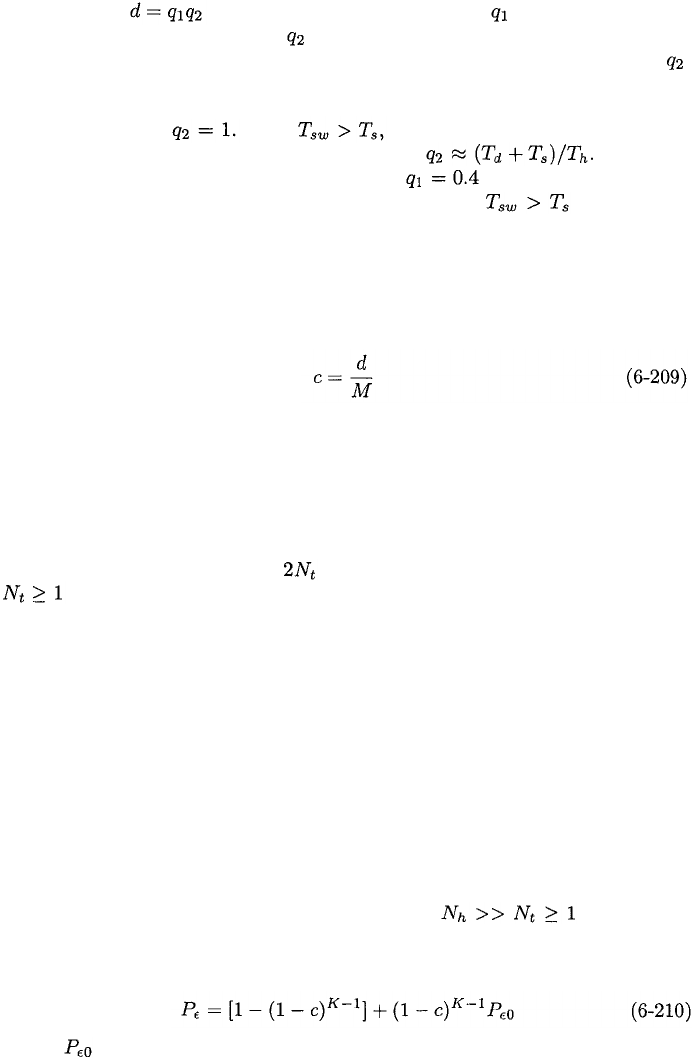
6.6.
FREQUENCY-HOPPING MULTIPLE ACCESS
363
an interferer using the same frequency channel will degrade the reception of a
symbol. Thus, is the product of the probability that an interferer is
transmitting and the probability that a significant portion of the interferer’s
transmitted waveform occurs during the symbol interval. The probability
is upper bounded and well approximated by the probability that there is any
overlap in time of the interference and the symbol interval. For synchronous
frequency hopping, Since it follows from elementary proba-
bility that for asynchronous frequency hopping, For voice
communications with voice-activity detection, is a typical value.
For asynchronous frequency hopping, the fact that ensures that
each potentially interfering frequency-hopping signal transmits power in at most
one frequency channel during the reception of one symbol of a desired signal.
Therefore, assuming that an interferer may transmit in any frequency chan-
nel with equal probability, the probability that a potentially interfering signal
collides with the desired signal during a symbol interval is
When a collision occurs, the symbol is said to be hit by the interfering signal.
For MFSK, M is given by (3-71).
Consider an FH/CDMA network of K asynchronous systems with negligible
spectral splatter and intersymbol interference. The code symbols are interleaved
so that each code symbol of a codeword is transmitted in a separate dwell
interval. Test symbols are used to determine erasures of all the symbols in a
dwell interval (Chapter 3). The test symbols are split into separate sets of
test symbols at each end of a dwell interval [28]. Thus, if a code symbol
is hit by one or more of the K – 1 interfering signals, then at least one set of the
test symbols in that same dwell interval is also hit. For analytical simplicity,
we make the following assumptions:
1. If at least one of the two test symbols at the opposite ends of a dwell
interval is hit, then an erasure is always made. Thus, if a code symbol is
hit, an erasure is always made.
2. If a code symbol is not hit, then this condition has a negligible influence
on the probability that one of the two end test symbols is hit.
3. The probability that both end test symbols are hit is negligible.
These assumptions are approximately valid if and the K-1
interfering signals have approximately the same or more power than the desired
signal. The first assumption implies that the probability of the erasure of a code
symbol is
where is the erasure probability given that no hit of the code symbol oc-
curred. Observe that if neither of the end test symbols is hit, then no test
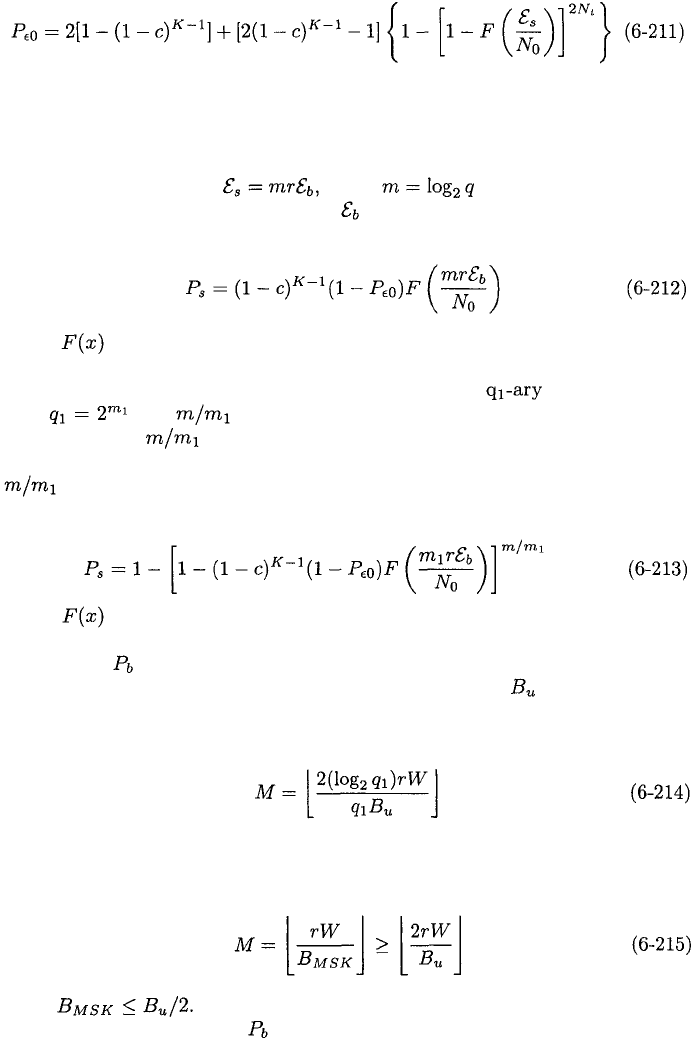
364
CHAPTER 6.
CODE-DIVISION MULTIPLE ACCESS
symbol is hit. Therefore, the assumptions imply that
where the first term is the probability that one of the two end test symbols is
hit, and the term in braces is the probability that although no test symbols
are hit, an erasure occurs because at least one of the detected test symbols is
incorrect. For MFSK modulation, each channel symbol is a code symbol and
the energy per symbol is where is the number of bits in
a q-ary symbol, r is the code rate, and is the energy per bit. Under the first
assumption, the code-symbol error probability is
where is given by (3-64) in the absence of fading and by (3-66) in the
presence of Ricean fading.
Suppose that each q-ary code symbol is mapped into channel symbols
with and chosen to be an integer. The channel symbols are
interleaved over dwell intervals to ensure independence of symbol errors
when the fading in each dwell interval, if present, is independent. Since all
channel symbols must be received correctly for there to be no code-
symbol error and the channel-symbol errors are independent, (1-32) implies
that
where is given by (3-67) for binary modulations with no fading and by (3-
68) when the channel symbols experience independent Ricean fading. Equation
(3-78) gives for errors-and-erasures decoding.
Let W denote the bandwidth of the hopping band and denote the band-
width of binary FSK in the absence of coding. For MFSK channel symbols,
(3-71) indicates that the number of disjoint frequency channels available for
frequency hopping is
which decreases with the channel-symbol alphabet size. The fundamental ad-
vantage of MSK is the reduced bandwidth per frequency channel. The number
of available frequency channels is
since
Figure 6.27 illustrates versus K-1 for FH/MFSK and FH/MSK sys-
tems that use a Reed-Solomon (64, 24) code with errors-and-erasures decoding
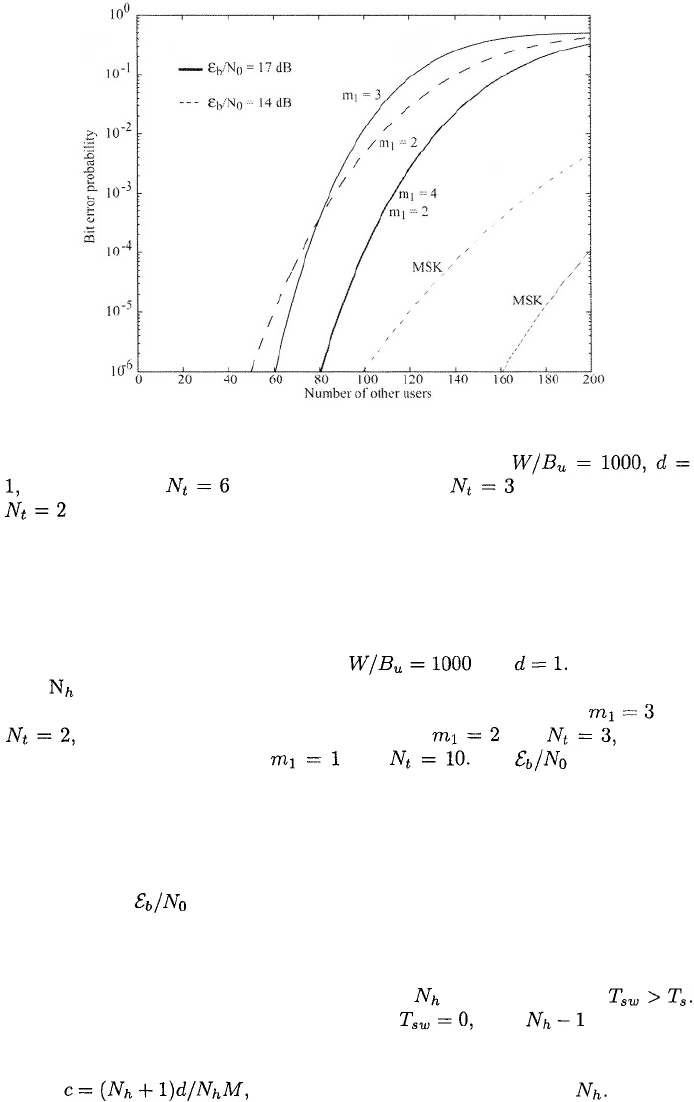
6.6.
FREQUENCY-HOPPING MULTIPLE ACCESS
365
Figure 6.27: Performance of FH/MFSK and FH/MSK systems with Reed-
Solomon (64, 24) code, various alphabet sizes, erasures,
and no fading. for binary modulations; for 4-ary FSK; and
for 8-ary FSK.
against asynchronous multiple-access interference in the absence of fading. The
graphs are computed from (6-210) through (6-215) with M given by the lower
bound in (6-215) for MSK. In all cases, and It is assumed
that is sufficiently large that there is no expansion of required bandwidths,
as illustrated in Table 3.1. The 8-ary MFSK channel symbols have and
the 4-ary MFSK channel symbols have and and the
binary channel symbols have and If
is sufficiently
large, the substantial benefits obtained from using binary or quaternary MFSK
channel symbols and the further benefit from using MSK are apparent in the
figure. These increases in the number of other users that can be accommodated
must be weighed against the disadvantage of binary channel symbols in the
presence of partial-band interference, as shown in Section 3.3. The figure illus-
trates that as drops from 17 dB to 14 dB, the FH/FSK and FH/MSK
systems degrade substantially while the nonbinary FH/MFSK systems degrade
imperceptibly. This result is due to the larger symbol energy of nonbinary
MFSK.
The results in the figure do not depend on primarily because
If one makes the unrealistic assumption that then symbols are
hit by an interfering signal with probability d/M, and the frequency transition
of the interfering signal causes one symbol to be hit with probability 2d/M.
Thus, which does exhibit a dependence on

366
CHAPTER 6.
CODE-DIVISION MULTIPLE ACCESS
T
o
obtain good performance against both partial-band interference and
multiple-access interference, a turbo code and binary channel symbols are needed.
However, even if is known, perhaps through power control, the turbo decoder
computation must be modified to account for the fluctuations from symbol-
to-symbol in the interference-plus-noise variance caused by multiple-access in-
terference [29]. When DPSK is the modulation, a suitable modification uses
(1-145).
If a turbo code is not feasible, then a Reed-Solomon code with errors-and-
erasures decoding is a good choice. However, for low to moderate thermal-noise
levels, a trade-off is necessary in the choice of the modulation. If one is pri-
marily interested in avoiding multiple-access interference, then binary channel
symbols are desirable. If stronger protection against partial-band interference
but weaker protection against multiple-access interference is needed, then non-
binary channel symbols are preferable.
The results in Figure 6.27 are based on the practical assumption of a fixed
bandwidth W. If this bandwidth constraint is dropped and W is optimized
to produce the maximum network throughput for each channel-symbol alpha-
bet size, then it is found that 4-ary or 8-ary channel symbols produce higher
throughputs than FSK in a frequency-hopping network [30].
Mobile Peer-to-Peer and Cellular Networks
Mobile FH/CDMA systems [31] are suitable for both peer-to-peer and cellular
communication networks. Mobile peer-to-peer communications are used in mo-
bile communication networks that possess no supporting infrastructure, fixed
or mobile; each user has identical signal processing capability. Peer-to-peer
communications have both commercial applications and important military ap-
plications, the latter primarily because of their robustness in the presence of
node losses. Power control and, hence, current DS/CDMA are not viable for
peer-to-peer communications because of the lack of a centralized architecture.
Current plans to use multiuser detection in direct-sequence CDMA systems still
require power control, which is highly desirable for the synchronization.
A unified evaluation of the potential performance of both mobile peer-to-
peer and sectorized FH/CDMA systems is provided by analysis and simulation.
The propagation path losses are modeled as the result of power-law losses, shad-
owing, and fading. In Chapter 5, it is shown that the probability distribution
function of the normalized local-mean power is
where is the average received power when the distance is
is the attenuation power law, and is the standard deviation in
decibels. The fading causes a power fluctuation about the local-mean power.
One method of combining antenna outputs is predetection combining, which
requires the estimation of the signal and interference-plus-noise power levels at
each antenna for maximal-ratio combining or selection diversity and requires

6.6.
FREQUENCY-HOPPING MULTIPLE ACCESS
367
the cophasing of the L antenna outputs for maximal-ratio or coherent equal-
gain combining. Since the relative phases and power levels of the signals at the
L antennas change after every hop, it is almost always impractical to implement
predetection combining. As a much more practical alternative, a receiver can
combine the demodulated outputs rather than the signals from the L antennas.
This postdetection combining eliminates the cophasing and does not require the
time alignment of L signals in practical applications because any misalignment
is much smaller than a symbol duration. The estimation of power levels can be
eliminated by the use of a fixed combining rule, such as equal-gain or square-law
combining.
In the receiver of a frequency-hopping system, each antenna output is de-
hopped and filtered. The interference plus noise in each dehopped signal is
approximated by independent bandlimited white Gaussian noise, with equiva-
lent power given by
where is the thermal noise power, K – 1 is the number of a
ctive frequency-
hopping interference signals , and is the local-mean interference power re-
ceived from source The Gaussian model is reasonable for large numbers of
interference signals that generally fade independently and experience different
Doppler shifts. The total interference power is approximately uniform (white)
over the receiver passband following dehopping if The L diver-
sity antennas are assumed to be close enough to each other that the power-law
losses and shadowing are nearly the same, and thus the local-mean power from a
source is the same at each antenna. Each active interfering mobile may actually
represent a cluster of mobiles. In this cluster, some discipline such as carrier-
sense multiple access is used to ensure that there is at most one transmitted
signal at any time.
The desired signal is assumed to experience frequency-nonselective Rayleigh
fading. The Rayleigh fading model is appropriate under the pessimistic assump-
tion that the propagation paths are often obstructed, and thus, the power of
the direct line-of-sight signal is small compared with the reflected signal power.
Frequency-nonselective fading occurs if Rayleigh fading may be neg-
ligible if mobile speeds are very low, which would occur if each mobile consisted
of a person walking. Shadowing would still occur but would be slowly varying
over time.
Spectrally compact CPFSK or GMSK signals do not have enough frequency
shift to be demodulated by classical noncoherent demodulators with parallel
matched filters and envelope detectors, but can be demodulated by a frequency
discriminator. We consider binary MSK with discriminator demodulation. For
postdetection diversity, the outputs of L discriminators are weighted and com-
bined. The weighting is by the square of the envelope at the input to each
discriminator. When the desired signal undergoes independent Rayleigh fading
at each antenna and the channel parameters remain constant for at least one
symbol duration, a calculation using the results of [32] yields the symbol error
